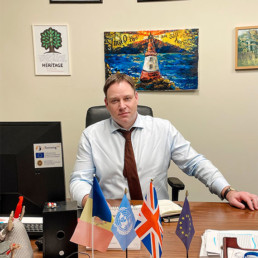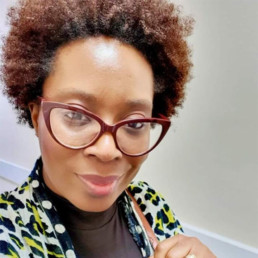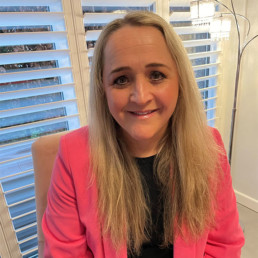Making the DEI mission of your school mean more than just words.

Written by Rob Ford
Rob is an educator for nearly 30 years, a history and politics teacher, a school leader in various schools in the UK and was principal of Wyedean School in the UK, before being appointed as Director of Heritage International School group.
“Our lives begin to end the day we become silent about the things that matter”. MLK
As my colleague sobbed with frustration and emotion in my room one afternoon, after a long day at school, going through what had just happened in class, I realised in that moment how powerless I felt there and then as a person but I knew how powerful my school’s culture, ethos and policies truly were in these awful moments. More than just words when put to the test to support my colleague as she asked for my help as a school leader.
My colleague, an international teacher, had been on the receiving end of a racist comment and it underlined to me just how much work we still have to do in our schools and communities to ensure such hurtful and offensive moments don’t happen especially when it comes to the words, beliefs and actions of children and young people in our care.
When we found the students responsible and put in place the necessary sanctions & follow up actions warranted, the comment from one parent said this to try and downplay the incident; “It’s like he was at the same table when the waiter was abused but all get thrown out of the restaurant”.
Illustrating perfectly with the choice of words that even the most liberal, educated, wordly wise and enlightened of school communities, especially those with many nationalities and a strong global outlook, need to continue to work together with the whole community, to challenge and change such mindsets. In contrast, the students were actually very contrite, apologised, owned their responsibility and repaired the damage done with their teacher who was prepared to move forward with them on this basis.
We cannot ever be silent on such issues as school leaders, nor should we feel powerless individually to tackle these issues successfully. We need to prioritise clear policies, culture, staff training and meaningful education in schools around issues & attitudes such as racism, nationalism, prejudice and hate that, unfortunately, have become more widespread in the 2020s around the globe. Doing nothing or hoping it won’t ever be something you will have to address is not an option either for any school leader.
Your school culture is not international because it says it in the title.
It is always quite surprising how many school leaders feel that issues around racism will never affect them because they are “an international school”. This is a very false assumption as much as stating how many different nationalities are in the school community. It doesn’t mean a school is diverse, equitable or inclusive and it’s a “lazy assumption” and derelict to avoid having a practical strategy in place because you say you are in the school’s name. Words matter here.
You need a robust Diversity, Equity and Inclusion Policy in place.
Your DEI policy should sit alongside the handful of ones, like Safeguarding, SEND, Teaching and Learning, Complaints, that you have in crumpled paper form, covered in notes and highlighter on your desk as a school leader because they are used as part and parcel of daily school life. There are some really effective, comprehensive and robust DEI policies out there to look at and adapt to your school.
Your DEI policy needs to be regularly reviewed, a governor responsible, a senior leader made responsible for it, and for it to be made publicly available, for your whole community to be aware of it with the key points clear. Get good outside experts to scrutinise it and for them to challenge you as a leader, your governors and your team on it as COBIS did to me and my school last year as part of our standards accreditation.
You need regular CPD for staff awareness and all your team believe and operate in this culture.
I couldn’t imagine annual staff training in August or regular CPD throughout the year, without time spent on our DEI, any more than I would leave safeguarding, the fire drill or Teaching and Learning out of what is central in the education and duty of care towards children. There are some incredible voices and forums out there for schools to follow and engage with and bring that outside expertise and experience to your school. Especially for schools and communities operating in homogenised and monoglot environments. Your DEI policy needs to be even more central in your strategy.
There are some incredible voices and forums out there for schools to follow and engage with and bring that outside expertise and experience to your school so tap into it; for example we have used Jon Gibson and Backdrop Education for staff training around inclusion and equity, America House in Chisinau extensively on diversity training, our governors have worked with Jackie Beard, a NLG and used the DEI programmes from NGA. COBIS have been working with Angela Browne and Hannah Wilson to deliver DEI training in schools and we are signing staff up for this outstanding & highly recommended programme for the courses this year. We also follow Hannah’s work in offering free DEI conferences and webinars to educators in the UK and around the World.
Raise student (and parental) awareness regularly, celebrating and commemorating our global, diverse communities in school daily life.
This is where you need to be prepared to be less than silent, especially in a World of labels thrown at schools such as “woke” or “cancel culture” for daring to celebrate and commemorate events in the global calendar such as Black History Month or Holocaust Remembrance. Do not shy away from what may be perceived as difficult topics or fearful of reactions.
In those school boards in the USA, where some parent groups are challenging schools for holding Black History Month events this February, because they believe it is teaching “CRT” (critical race theory), school leaders are tackling this challenge head on legally as we finally see this “false equivalence” called out and for a many, a hill definitely worth a stand on.
In Eastern Europe, the ugly racism black English footballers endured recently playing Hungary, became a very good debate topic for our IGCSE and A Level students and I was proud to see all of them call it out for the hate and ugliness it was. These are not the values these students want or their part of the world to be associated with.
We also are facing in Eastern Europe the contextual challenge of the conflict of Russia towards Ukraine, with students of both countries in our community, so we have worked with teachers on how to handle difficult questions on it and deal with issues that may arise from students in a safe arena of dialogue. This is the very reason why we educate children.
Make your community more inclusive and diverse.
This should include a recruitment policy that is more than just centred towards white Anglo-American educators and truly brings the global community to your school. I still hear the positive words of one of my students when she said coming to Heritage is like going abroad each day.
The same is about the speakers you have in school, the role models for children chosen and what you study in the curriculum. I have no issue with special days or months for events in the global curriculum calendar because it is a good excuse to highlight the work that is consciously there daily and it is not just for one day.
Schools shouldn’t worry about the odd criticism on social media because you celebrate or commemorate one day either, as long as this isn’t the only time some topics or events are looked at and studied. A “one off” is not a school culture but it is a good starting point to build on. Throughout this academic year, the UN’s #FightRacism campaign has underscored so many wider curricular events especially through whole school assemblies and cross curricular days we have aligned with as a school.
Conclusion.
We should live up to our school’s mission, culture and ethos, especially where we want future leaders to lead with the very values we claim we are about in our schools to young people including diversity, equity, justice and inclusion for a better future. Or as school leaders we will end up remaining silent on what matters most.
Ukraine, Russia, Palestine, Israel, Afghanistan, Covid-19, Climate Change…and so much more: how to get Political Impartiality right.

Written by Zahara Chowdhury
Zahara is founder and editor of the blog and podcast, School Should Be, a platform that explores a range of topics helping students, teachers and parents on how to ‘adult well’, together. She is a DEI lead across 2 secondary schools and advises schools on how to create positive and progressive cultures for staff and students. Zahara is a previous Head of English, Associate Senior Leader and Education and Wellbeing Consultant.
The last few weeks, or perhaps years, feel like a surreal blur when thinking about our global context. From the outbreak of Covid-19 to the recent war in Ukraine, it is now as if we are living through the dystopian and historical literature I once taught through fictional and non-fiction texts in the classroom. As teachers and educators there is an expectation that we not only educate students about these topics, but we must know and be aware of every article and news feed that emerges on a daily basis. In many ways, the recent Political Impartiality Guidance released by the DfE was as much to refresh our responsibilities as educators, but also to reassure teaching professionals too; unfortunately, social media coverage and wider analysis of the guidance seems to suggest the opposite. Our students and colleagues want to learn, discuss and explore current affairs, but how do we do this in light of this guidance and a school climate, where GCSEs, A Levels, limited time and limited resources dominate?
Much of the specific economic and political facts go over my head (even as a DEI Lead). Equally, my advice to teachers and schools is that you do not need to be a global, political, geographical or economic expert to address these matters. Instead, in order to get political impartiality ‘right’, whilst prioritising curriculum, teaching, learning and pastoral needs, we must remember what teachers and schools do best: we can critically navigate and evaluate the differing perspectives of world politics without being political. We can support students in how to challenge and respectfully discuss contentious topics. We can also help our students learn to be empathetic, acknowledge their emotions whilst being mindful of others too.
However, this in itself is challenging considering the ‘diversity’ within teacher training and lived experiences too. To help teachers and education professionals, below are some key learning points and explanations that can help schools get political impartiality right; if we are aware of them, we are more likely to create inclusive, safe spaces for all of our students and staff too.
Media Bias
There has been an outpouring of sympathy, global empathy, local and community charity and Influencer support for Ukrainian refugees – and rightly so. It has been heart-warming and necessary to see so many come together at a time of intense suffering to protect and support our human race. However, the media coverage and perception of refugee status has been problematic. In many ways, it seems some Western media outlets have usualised poverty, strife, pain and refugee status for particular races and regions but portray it as wrong for Western, white, ‘blue eyed’ individuals to experience the same. The question for teachers that might arise here is how do we explore such controversial media bias without making it ‘political’?
Aisha Thomas, founder of Representation Matters, asks a pivotal question: what story is your curriculum telling – a question that could not be more relevant in light of media bias, social media algorithms and being politically impartial in the classroom.
- Does your curriculum teach success stories from the East, North, South and West?
- Does it teach socio economic barriers (and opportunities) in the West, East, North and South?
- Is it gender equitable?
- Does it elevate the voices of all protected characteristics? Does every member of your class ‘see’ and ‘hear’ themselves in lessons?
- Is it intersectional?
- Is it fair?
- Is it truthful?
- Does it allow students to question, critique and evaluate the situations independently?
These are worthwhile questions to bring to the forefront of any CPD training and classroom work you do to strategically address belonging, equity, anti-bullying and teacher/student safety.
The media sources referenced above also contain bias – pretty much everything we read, see and explore does. However, it is important to explore the language and literacy of a range of media sources so students are able to have critical, mature and nuanced discussions – what every school ultimately aspires to!
Selective Empathy
Selective empathy is when we empathise with a particular group, particular causes and people for many reasons: it is dominant in the news; we relate to it, or maybe it feels close to ‘home’. Whatever ‘it’ is, it somehow resonates so much that we find ourselves becoming socially just, publicly outraged and visibly allying with a particular cause or issue. For example, you may notice that certain members of staff or students visibly ally with some causes more than others, whether that be the war in Ukraine, the Israeli-Palestinian conflict, anti-Semitism or LGBT+ rights.
Being selective in how and with whom we empathise in a globally diverse society is problematic. In many ways, it can lead to ‘whataboutisms’, alienation and further antagonism. If we are really committed to creating a diverse and inclusive world where protected characteristics need not exist and everyone feels a sense of belonging, we must approach all areas of DEI consistently – with nuance and transparent, shared values. Schools, teachers and students will need to ask themselves how they are creating safe, equitable spaces of belonging regardless of geography, economics, beliefs and values. Individuals with and without protected characteristics, individuals from marginalised and non-marginalised backgrounds need work together to create a sustainable culture for DEI. Equally, centralising ‘lived experiences’, the intersections of society and people who often fall victim to decisions and events beyond their control are who we need to ally with – they need our voice and their voices amplified. This is not political, that is just empathy and being human.
However, acknowledging our empathetic responsibilities can feel jarring; it can make some feel uncomfortable, critique ‘woke culture’ and more. Some may feel they are able to unapologetically selectively empathise – why should it matter that I empathise with one cause more than another? Why does it matter that I share my outrage for the war in Ukraine but not Syria? The answer to this question requires some introspective work:
- if we felt uncomfortable advocating for the rights and safety of Palestinian citizens in the Spring/summer of 2021, but little discomfort advocating for the safety and rights of Israeli citizens (I am using citizens and geography intentionally here as this is not a Semitic discussion), we must ask why? Does this discomfort or lack of responsibility enter your sphere of allyship with Ukrainian refugees? If not, why? If yes, why? If you feel your heart pang when you see your child or your students in a young Ukrainian child, but not in a Palestinian, Afghan or Syrian child, question why? If you are collecting charitable donations for Ukrainian refugees but this did not necessarily feel as urgent or necessary last summer again, question it. Do you find supporting and understanding the barriers faced by the LGBT+ community more accessible than anti-racism? Why?
These are difficult questions. They are challenging, jarring and some may choose to dismiss them immediately. I encourage you to work through the discomfort and potential feelings of offence. This is not a criticism, unnecessary ‘wokeism’ or misplaced social justice work; this is a call to critically address and navigate feelings of empathy. Empathy is a skill that needs to be nurtured and learned. Allyship is a set of actions that need to be consistently practiced and addressed. This is only possible if we are always sitting and working through our discomfort. It does not need to shake our core values and beliefs – instead, it reinforces that our core values and beliefs are wholly inclusive and respectful of all human life – not selective.
Intersectionality
The last 3 years isn’t a movie set in the past or a book we might be currently studying in lessons. It isn’t a case study for exam boards (yet). It is the lived experience of all of us. There are intersections to recognise, people to listen to and an opportunity to learn about globalisation, economics and geography in real life. Ask students what changes they’ve noticed: Chanel, Netflix and more no longer trading in Russia- what does this actually mean for the global economy, but also the different intersections of society? Create opportunities to learn about the intersections of economics and business and what the world will look like beyond this war. Ask students to question the impact of certain decisions and suggestions they see (and potentially support or refute) on social media. This can help overcome the fear and uncertainty associated with the current global climate – along with create opportunities for young people in a new and equitable manner.
Explore global inequality and diverse perspectives – why and how is the current world a result of a past world? There are multiple answers to explore here. This is where history, PSHE, RE, Geography, Economics, Philosophy and Politics can take precedence on the curriculum. Consider the questions and ways in which these topics are explored in their relative subject areas and how other subject areas can adopt their approaches. How can we make changes or additions to curriculum areas to explore wider perspectives?
Intersectionality is in effect, the very key to the success of every student, regardless of their background, protected characteristic, lived experience and more. An appreciation and amplification of nuance within our schools, society, student and staff body will create a culture of belonging and there is plenty of research to suggest that ‘belonging’ leads to success.
It is possible to remain politically impartial and work within a rich and valuable teaching environment. If we take a proactive, diverse and critical approach to current affairs we will be able to overcome the fear and discomfort associated with discussing ever-changing global and social climates. And, ultimately, we have the power in a classroom to create trusting and safe spaces for our students, communities and professional bodies – something that often goes amiss in the ‘politics of social media!
Cultural Intelligence

Written by Wangu Chafuwa
As a first generation immigrant, Wangu’s vantage as an insider-outsider led to a fascination in people, social relations and culture, which led to advocacy work with the British Youth Council. Wangu now uses his social consciousness and anthropological perspectives to bring human centred insights to the world of work.
Culture – and how we move through it – has also become one of the tabloids’ favourite news beats. How often do we see articles bemoaning the rise of cancel culture or so called culture wars? It’s understandable why lots of us feel nervous about approaching culture.
Even in itself culture is a difficult term to define. The Oxford English Dictionary contains 6 distinctly separate definitions of it: ranging from ‘the civilization, customs, artistic achievements, etc., of a people’; to ‘the artificial development of microscopic organisms, esp. bacteria, in specially prepared media’; to ‘the training, development, and refinement of mind, tastes, and manners’.
Culture is one of those funny little terms we all vaguely seem to understand but struggle to pin a precise meaning to. Which poses a problem as we’re routinely expected to navigate increasingly complex cultural environments.
It’s the reason why Cultural Intelligence (or CQ, like IQ) has been described as one of the essential leadership skills of the future. But how well do we understand what that really means?
There’s a phrase that’s probably misquoted to Einstein that says ‘intelligence is not the ability to store information, but to know where to find it’. Often when people hear Cultural Intelligence they think that it means having an itinerary of do’s and don’ts for cross cultural
interactions. Having this knowledge is obviously helpful, but the thing about Cultural Intelligence is that it is a practice – it has to be applied.
“But how?”, I hear you utter in anguish from beyond the screen.
In his 2011 book, “The Cultural Intelligence Difference,” Dr David Livermore highlights four capabilities to develop to effectively practise Cultural Intelligence:
CQ Knowledge relating to knowing different cultural expectations and the nuances of intersectional cultural expressions.
CQ Strategy relating to your ability to plan and prepare for multicultural interactions.
CQ Action relating to how appropriately you adapt your behaviour to accommodate different cultural contexts.
CQ Drive your interest and motivation to keep finding out more about different cultures.
Cultural Intelligence is the acknowledgement of the fact we all come from different places that hold deep meaning to us and a respect for how this shapes our individual perspectives. No one wants to be treated in aggregate. Practising Cultural Intelligence allows us to see people in their rich difference rather than one in an anonymous blob.
Our struggle to get to a singular definition of culture isn’t a failure to express, it’s a representation of the living, transforming and always shared experience that is culture.
We can see this buzzing diversity inherent in culture in the sheer number of different cultural expressions living around us. In all this contrast and colour is an infinity of possibilities. And the ever-present potential of friction.
The capabilities underpinning Cultural Intelligence may sound a bit jargony but luckily underpinning them is an innate capability to navigate our inherent differences. We are social creatures – all possessing empathy muscles that hardwire us to build bridges between us.
The Non-Linear Road To Recovery

Written by Bianca Chappell
Bianca Chappell is a Mental Health Strategic Lead, Cognitive Behavioural Coach and Mental Health First Aider.
When things go awry, we like to know what to do and how to do it, so that it can be sorted out – it’s a totally natural response. With some illnesses, the treatment is simple and we are able to move on. Unfortunately, mental ill health isn’t so straightforward, and to make it even more frustrating, recovery is hardly ever linear either – we don’t experience feeling better in a nice, neat, straight line.
Life is mostly unpredictable and there’s only so much that we can control. Our mental health can take a knock-back from the things which go on internally for us, but also the things which happen externally.
We may have been going along all hunky-dory and then something happens to cause one of those sinking-stomach rough patches that we work so hard to avoid. Similarly, we might have had a long murky spell and then find that something happens to give us a lift.
Our mental health isn’t stationary, it’s transient and a counter reaction of so many individual factors. It’s difficult to always know what’s helping and what’s not, to be able to make changes to rebalance and create new habits to feel settled again.
It’s hard work and sometimes we’ll put time and effort into something that isn’t quite right for us which can be demotivating and use up energy which is in limited supply. The very nature of mental ill health is that it depletes our energy resources, so we’re always having to weigh-up where we are, with where we’d like to be, but to also be mindful that we’re not using up all of our future energy supplies. It’s a never-ending puzzle.
Life in itself is full of ups and downs. When we add mental ill health to the mix, those lows can feel extraordinarily painful and crushing. We’re working so hard to move forwards, towards good health, and those setbacks can really dent our hope and confidence. We might find ourselves in a spiral of ‘well I’ve tried so hard and things are still going backwards so everything is hopeless and I’ll never get better so there’s no point in trying any more’. It can be very easy to get into this spiral and it is very hard to get out of it again. Hitting a blip doesn’t mean that everything is hopeless and it certainly doesn’t mean that all of our hard work is for nothing. When it all feels a little much, take some time out to hunker down and up the self-care. It can feel counterintuitive but energy, hope and motivation aren’t in limitless supply, we often need to stop, to take stock and top-up.
On the face of it, it often seems as though there’s no logical reason for our mental health deteriorating. But there’s usually something, however small it might seem, which has affected how we feel.
It can take a bit of work to figure out the sorts of things that might be contributing to our mental health dipping; habits, boundaries, obstacles, lack of support, triggers etc. We might need some help with identifying what our triggers are and in learning how to handle them. One of the things which can help is to keep a mood diary – this helps us to see patterns but also gives us an in-time reflection on what was what for us at any given time.
The more knowledgeable we are about our stressors, the more equipped we are to make decisions which are right for us and our mental health.
When our mood dips again, or we use behaviours we haven’t used in a while, it’s easy to feel hopeless, useless, and frustrated. We might find that we feel like nothing has changed, as if we’ve not got anywhere, and nothing is any different from last year, or the year before that, or the year before that.
Relapsing doesn’t erase our recovery. All the things we’ve achieved – keeping our mood stable for a while, going for a period of time without using behaviours, or something else – are still achievements.
When we look back, it’s the grotty and the great that we see – but the in-between stuff is just as valuable; there’s important knowledge we’ve gained and lessons we’ve learned which help us to be more informed going forward. Every time we go through a rough patch, we can take an insight from it to aid our recovery. Even though it might not feel like it, we will be in a different place from the time(s) before. We have more experiences and more skills than we’ve had in the past. We never go right back to square one because we’re approaching each rough patch from a slightly different place.
Mental ill health isn’t something we’d choose and it’s definitely not a stick with which to beat ourselves up about. We didn’t choose to be mentally ill in the same way that we don’t choose to catch a cold. When we punish ourselves for how we feel, it makes us feel worse and plays into the hands of the illness we so want to be free from.
Not being okay can be hard to cope with, we so desperately want to be okay, but it is okay not to be okay. Nobody can be okay all of the time and recovery will always be full of ups and downs as we learn new things. It’s when we own-up to our not-okay-ness that we find ourselves in a place more accepting of help, more likely to ask for help, and more open to changes, self-care and being gentler to ourselves.
The Intersection of Race and Neurodivergence

Written by Anu Roy
Anu is a TeachFirst leadership Alumni and digital trustee and teacher committee lead for charities in England and Scotland. She is currently a digital curriculum development manager and works in inclusive education projects incorporating tech.
‘Just stop fidgeting please’.
I have been told this my entire life and truthfully, I have then said the same sentence to students during a lesson. Students who do not seem focused, who might have lost their pen, cannot find the right page. As teachers we all know these students, but with that sentence -do we run the risk of reducing them to something they cannot control?
Traditionally, the narrative around restless behaviour in the classroom can be characterised as an uninterested student, potentially becoming disruptive if the teacher does not intervene. However, neurodivergent students with ADHD may find it difficult to focus, feel restless and struggle to overcome impulsive behaviour. This is particularly challenging for BAME neurodivergent students who are continually underdiagnosed for ADHD, making it harder to raise awareness and create an action plan to support them.
In our current education system, I have realised that there are BAME students who have struggled from nursery all the way to their graduation at university with difficulties which arise from ADHD as a root cause, but they were never diagnosed. The inequities of treatment and resources coupled with the systemic barriers faced by people of colour can mean that the joy of learning is lost when these students feel like they are not meant to succeed. Instead, educators have a duty to shape systems which support neurodivergent students and address their barriers to learning.
The next time we see a student looking restless, instead of assuming they are disinterested, it is important for us to take the time and speak with them about whether they have trouble concentrating and what measures we can put in place to help them navigate that. When all students are excited and keen to learn, what we can accomplish in the classroom knows no limits.
Teachers Working from Home - Working Hard or Hardly Working?

Written by Lindsay Patience
Lindsay Patience is the co-founder of Flexible Teacher Talent. She is a Teach First Ambassador, a School Leader and a mother.
A recent TeacherTapp question asked how people felt about heads, senior leaders and teachers having a regular day to work from home. Here are the results:
Should HEADTEACHERS be allowed a regular day to work from home?
13% Strongly agree 30% Agree (43%)
22% Disagree 22% Strongly disagree (44%)
Should SENIOR LEADERS be allowed a regular day to work from home?
11% Strongly agree 30% Agree (41%)
27% Disagree 22% Strongly disagree (49%)
Should TEACHERS be allowed a regular day to work from home?
14% Strongly agree 33% Agree (47%)
30% Disagree 14% Strongly disagree (44%)
Obviously, given my love of all things flexible working, these responses left me perplexed and frustrated. Why shouldn’t heads, senior leaders and teachers work from home one day a week? What if they would do a better job if they worked from home? What if that meant we had better retention, recruitment, motivation and productivity in the education sector? Why do more people disagree that senior leaders should be allowed to work from home than they do for heads? What could it be that made people disagree with this?
Is it because they think school staff need to be in school?
Of course, they do. But all the time? Not all of our working time is in front of out pupils. In fact, heads have the least contact time in the classroom or elsewhere with students, so they have the greatest opportunity to work from home. Similar for senior leaders. Working from home is more possible for them because they don’t have so many face-to-face lessons.
The lockdowns showed us (in a very unplanned and unexpected way) that a great deal can be achieved away from the school site. It obviously was not an idyllic situation and outcomes and working conditions were often inferior to what we could have achieved in school, but there were some aspects that showed us we didn’t need to all be on site, all of the time. Staff communication, briefings, CPD, parents meetings, using software for assessment and for meetings and many other things. If we could make some of those things work when we were thrown with no warning into such an unprecedented situation and some of them were effective, just imagine how successful they might be if they were planned and utilised strategically. Working from home is one of those things.
Is it because the more senior you are, the more important it is that you are in school?
Heads and senior leaders often have administrative or strategic work to do that would be better conducted privately, quietly, uninterrupted in a work environment that suits them. This may not be in school. This might also be true for teachers, why does PPA have to be on-site? I have never been able to plan effectively at school. My best planning is when I am at home with time and space to reflect and I find it more conducive to creativity. I mark best in cafes, in fact it is the only place I can productively mark away from distractions at school and home.
Maybe those who disagreed just did so because it doesn’t seem possible?
Full time teachers with 10% PPA get half a week out of class, not one full day. So maybe they interpreted the question as one day a week and immediately said no as they assumed it meant time away from classes?
Or maybe there is something else going on here as mentioned in the Teacher Tapp blog on the findings. They mention the “phenomenon that people typically don’t like it when their colleagues are given a benefit which won’t be extended to them.”
Why did more people disagree about senior leaders than heads? Is it something about the job role? You have to be present and in school dealing with issues as they come up? More important as a senior leader than as the head?
Is it because we just don’t trust people to work from home?
Media coverage of the pandemic showed that there is a sentiment that those working from home rather than the office are not working as hard. There are images of people lounging around in their PJs, looking after their kids at the same time, generally not working hard. But really this just boils down to lack of trust in people as professionals. So what if someone works in their PJs if they still get the work done, maybe they are more productive in their PJs. Accountability is important but it doesn’t disappear when people work from home. They still have to do the work and get the results. Some managers just find it problematic if they can’t heavily supervise and monitor workers and so don’t trust them to work from home. Echoes of this are shown again with Teacher Tapp data from the following week suggesting only 15% of teachers are allowed to have their PPA time off site. Why is this figure so low? Why can’t teachers do their planning, preparation and assessment time outside of school? It is dedicated time when they are not to be scheduled for contact time or other commitments so why can’t they have more autonomy in where and how they use this time?
The positives of working from home
Well, here is why I was strongly agree that some time working from home would be good for teachers, senior leaders and head teachers:
Working from home is more productive
A study by Standford of 16,000 workers over 9 months found that working from home increase productivity by 13%. This was attributed to a quieter more convenient working environment and fewer breaks and sick days. Workers also reported improved work satisfaction, and the rate of employees leaving was cut by 50%.
77% of those who work remotely at least a few times per month show increased productivity, with 30% doing more work in less time and 24% doing more work in the same period of time according to a survey by ConnectSolutions.
A study conducted by Ask.com found that 86% of employees prefer to work by themselves when they are trying to be as productive as possible. There are many tasks that would be much easier without constant interruption. Schools are noisy, busy places by their nature. They are also not always particularly well kitted out or designed as staff work spaces.
And in schools, better productivity, means better outcomes for our pupils, but also better use of public money.
Working from home attracts and retains a diverse staff
What if your heads, senior leaders and teachers can’t work full time? What if they don’t want to work full time? Without flexible working, you miss out of candidates, you miss out on diversity, you miss out on experience and perspective and the opportunity for effective succession planning and development.
Working from home makes us happier
Another US study reported that 82 percent of telecommuters said their overall stress level was lower, while 80 percent reported higher morale because they worked remotely. Other reported benefits of working from home include: less commuting time and more time for wellbeing. Time spent working from home can mean more time for hobbies/pets/time with family/exercise. We are better teachers if we are happier, which is better for students, and relationships, and retention etc.
Also, just give the people what they want! 91% of the UK’s office workers would like to work from home at least part of the time. I know teachers aren’t office workers as such but such overwhelming positivity about working from home must be somewhat reflected also in out staff bodies. It is also worth considering that if office jobs continue to offer hybrid work environments but schools do not, it will be harder to recruit career changers and those currently working in schools who are looking to leave may find more attractive working conditions in other industries.
So that turned into quite a long essay in support of working from home! But I feel strongly that if the education sector doesn’t embrace flexible working and make changes to facilitate it then our schools are missing out on diversity, retention, motivation and productivity that is crucial for our children. Working from home doesn’t mean never being on site, flexible working doesn’t mean teachers walking out on a class in the middle of the day. Our traditional school structures don’t lend themselves well to flexible working but more importantly neither do our attitudes and the cultures in our schools. Flex can work in schools, there is a growing evidence base of case studies showing this, but we need to change how we think about flexible working. Embrace the benefits and make changes to allow them to be taken advantage of.
Working from home reads/references
Has the use of VAK changed at all since 2018? – Teacher Tapp
Surprising Working From Home Productivity Statistics (2022) (apollotechnical.com)
How Working from Home Makes People Happier – Remote.co
The productivity pitfalls of working from home in the age of COVID-19 | Stanford News
Ten Facts You Should Know About Telecommuting (baselinemag.com)
Coronavirus: Why some people want to keep working from home – BBC News
How East Stanley Primary School used Rainbow Laces to build a more inclusive environment for its pupils

Written by Adam Walker
Adam is a Primary Teacher at East Stanley Primary School in Durham and is a member and advocate of the LGBTQ+ community.
‘The number one thing is the inclusivity benefits of the resources. Not having pupils question who is playing football and building a much deeper level of respect for each other.’
Creating an inclusive environment for pupils is a top priority for many teachers and their schools. As we celebrate LGBTQ+ History Month, Adam Walker, a teacher from East Stanley Primary school tells us about how using the Rainbow Laces resources, from Premier League Primary Stars, helped create a more inclusive environment for his pupils – increasing their understanding of gender stereotypes and the LGBTQ+ community.
“We had an incident at a football match a few years ago where a pupil from our school called a player from another team a homophobic slur. It was at this point we realised that we needed a solution that we could use to support our pupils in understanding the importance of being inclusive. After a long search to find the right solution, we came across the Rainbow Laces resources from Premier League Primary Stars. A bank of free resources that could educate our pupils around the importance of inclusivity, challenging stereotypes and being a good ally – it was exactly what we were looking for.
At East Stanley we are seeing more girls wanting to get involved in sport. So it was great to see Premier League Primary Stars use male and female professionals in their resources to show balanced representation of real sport. Activities such as ‘Do it like a…’ and ‘Be an ally’ have been popular with the pupils. It has especially given the girls something to look up to and through challenging stereotypes we have mixed teams playing football with a deep level of respect for each other.”
East Stanley has used the Rainbow Laces resources in PSHE lessons at the school to create a more open environment: “The Rainbow Laces resource pack helped us in our PSHE lessons when talking about what it means to be a part of the LGBTQ+ community or discussing gender stereotypes. Now all the pupils are aware of different types of representation; they know that it doesn’t matter if you are homosexual or heterosexual, a boy or a girl, your ethnic descent, or what your first language may be.”
As a member of the LGBTQ+ community, Adam appreciates the difference that resources like Rainbow Laces make: “Now that I have these resources I reflect and think that if material like this had been available when I was in school, it would have helped me to identify and feel more comfortable as a result of inclusive topics being spoken about openly. The more we use material like this in primary schools, the more we will create a better environment for everybody to live freely. It is only going to have a positive influence.”
Speaking about whether he would recommend the resources to fellow teachers, Adam said: “I would 100% recommend them. Knowing how the PSHE curriculum works, Rainbow Laces has been great for us. For other teachers who are looking to increase inclusivity at their school, we have loved the outcomes the resources have given us. Premier League Primary Stars has a wide variety of resources too and there is also the opportunity to build Rainbow Laces – and others resources – into additional lessons around Maths, English and PE. We have seen a real difference and our pupils are happier as a result.”
At the end of 2021 and during the Premier League’s Rainbow Laces campaign, Premier League Primary Stars launched a new resource pack called ‘Rainbow Laces – This is everyone’s game’. The pack, perfect to build into PSHE lessons this LGTBTQ History Month, includes an educational film, and supporting resources, celebrating LGBTQ+ football fans and showcases the power of football to bring people together. The film tells the story of a young Sheffield United fan and member of the LGBTQ+ community, who talks about what football means to her and how it has played a part in helping her to feel proud of who she is.
Premier League Primary Stars has a wealth of dedicated LGBTQ+ and Anti-Discrimination resources – all free – for teacher to use in the classroom linked to English, Maths, PE and PSHE here.
About Premier League Primary Stars
Premier League Primary Stars is a national primary school programme that uses the appeal of the Premier League and professional football clubs to inspire children to learn, be active and develop important life skills. Clubs provide in-school support to teachers, delivering educational sessions to schools in their communities. Free teaching materials ensure the rounded programme, which covers everything from PE and maths to resilience and teamwork, is available to every primary school in England and Wales.
The Premier League currently funds 105 Premier League, English Football League and National League clubs in England and Wales to provide in-school support for teachers.
For more information about Premier League Primary Stars or to register, visit: www.plprimarystars.com
You can also contact Ben Lewis-D’Anna on blewisdanna@everfi.com or 07590465455.
Maximising Connection During Maternity Leave

Written by Liz Cartledge
Senior Vice Principal at a large Secondary School in Sheffield. Leader of Inclusion, Behaviour and Designated Safeguarding Lead. Liz is the mother to twin girls and returned from maternity leave in September 2020.
As a leader, the constant care of students and staff is arguably the most important and biggest responsibility in the long list of daily tasks. Getting the balance right and knowing what to do in each unique case can be hard.
It is true that we learn through our mistakes, however, sometimes it is helpful to be able to reach for some real-life guidance. Sometimes the hardest of experiences can make us the strongest. I personally experienced a lonely and isolating maternity leave due to the COVID-19 pandemic and lockdown in 2020 and thus feel I can offer some useful insights and support to schools who want to ensure their staff on maternity leave are cared for.
Since returning to work, I have often been asked to support other newly pregnant staff and on occasion those off with long-term absence. I feel empowered to help staff and one key reason I cite for this is because I feel confident sharing my own personal struggles and vulnerabilities, which I encountered on the journey to motherhood. Through Nourished Collective who featured a series called Mother, Sister, Daughter, Woman (Copy of This is How We Look (mcusercontent.com)), I shared my story which has helped me to break the silence that can exist around this issue. This has helped me personally and professionally to become a stronger leader.
The key is to build a school where staff feel valued, heard, and listened to. Sharing my story has given me the drive to know I can provide others with the space and empathy they need. It doesn’t matter what the issue is, if we, as leaders, are open about our emotions it can mean we are relatable to others; so I urge you to be vulnerable and see the benefits from it.
Recently, I have been considering the support we provide our staff with whilst on maternity leave. During my maternity leave I experienced reduced support, no baby groups and limited access to a GP. Maternity leave can be incredibly lonely and isolating. Connection is therefore key, and schools can provide this.
Within any school there is an abundance of knowledge and talent. Schools can offer emotional sanctuary and security. New parents/carers should be encouraged to share photos and updates regularly with a key member of staff. Furthermore, if you have a few members of the team off at once, could a group (perhaps via WhatsApp or equivalent) be set-up pulling all together?
I am often asked to be the key person identified to talk to new or soon to be new parents/carers. Currently, I am in regular contact with new Mums on maternity leave to provide them with a close connection with school. This helps us keep in touch and is a lifeline on some days for those Mums. I know this having cared for twin babies during a pandemic!
Do you offer this 1:1 support for those on maternity leave? Do staff have the chance to have 1:1 chats with a named ‘go to’ person on SLT? Could this help morale and well-being at your school if you make these subtle changes?
What kind and frequency of contact do you have with those on maternity leave? They are, after all, still employed by the school doing what is arguably the most important job of their lives. We owe it to them.
Remember, as leaders we can make a huge difference. Simple acts of kindness go a long way, sending cards or flowers can help bridge the gap that can grow when on leave. Creating a sense of family first is vital for staff retention.
Occasionally, without bridging this gap, we can risk staff being anxious to return or not returning at all.
Another key step to helping staff on maternity leave is to give them knowledge. By making them aware of the policy, for example what KIT (Keeping in Touch) days is a great start. It should not just exist in a policy given to staff to read. This could become part of pre-recorded videos shared with staff or information passed on in a 1:1 meeting before they leave. The impact of doing this is that it helps staff to be empowered and feel supported at this important time.
When staff do return, make sure they have the chance to meet a key person they feel comfortable with and that well-being chats are regularly put in. A review meeting 6 months or sooner after returning is a must to help the member of staff feel supported and to be able to reflect on how they are coping with work alongside parenthood.
Remember, it takes time for the member of staff to adjust to work. Schools move at a fast pace, and we must be patient. Small steps are acceptable. Don’t be too hard on yourself if you are returning and don’t expect too much if you have someone returning, at first- be flexible! Personally, it took me 12+ months to be myself again at work. Letting staff know this is great for their self-confidence and self-esteem which can be very low with sleep deprivation!
Celebrating the return of staff from maternity leave is important to share with all staff in briefings, in newsletters with parents/carers and with governors. It helps everyone see the member of staff returning as a new person which I feel is supportive and celebratory of their achievement/s!
The more we share, the greater the understanding will be for all and the greater the potential for empathy can begin.
The Need for Equity in Education for Those Trying to Conceive

Written by Caroline Biddle
Consultant, fertility coach and fertility advocate. Founder of Fertility Issues in Teaching.
The journey to parenthood isn’t always straightforward, with assisted conception being a route for many couples and individuals.
1 in 6 people in the UK are infertile, and in the last 10 years there has been an increase in women in same sex relationships looking to assisted conception for support to grow their families, as well a significant rise in those deciding to head down the route of fertility treatment to become a solo parent.
Female employees need time out of work to access fertility treatment
Male infertility accounts for 50% of infertility, nevertheless it’s women who require the time out of work to attend clinic appointments for scans and surgery.
The Teachers’ Fertility Treatment Survey is the first ever survey of its kind, gathering data from female teachers (including those who have left education) that have accessed assisted conception in the past 10 years. Data collected from the survey will provide an accurate insight of what is happening in schools in England and Wales as we unearth:
- How career progression of these women has been affected
- The percentage of schools that have fertility policies in place
- The impact of the support and the lack of support on female staff accessing assisted conception
- The wellbeing of staff members receiving fertility treatment
Employees can be surprised to learn that assisted conception in most school HR policies is referred to as ‘elective treatment’, meaning they find themselves compared with someone who wishes to have a breast enhancement during term time.
Categorising fertility treatment as elective is outdated.
The word ‘elective’ implies that fertility treatment is a lifestyle choice. This is discriminative terminology towards those with the disease of infertility and also to those in same sex relationships and who need assisted conception to have a biological child, or women who require treatment to become a solo parent for reasons such as having no partner, or having recently come out of a long term relationship.
Why we need assisted conception policies in the workplace
We need assisted conception policies in every workplace. In schools this policy will ensure that all teachers who are trying to conceive, no matter what their circumstance, are included, protected and supported.
Thousands of teachers are leaving the teaching profession every year, due to burn out or a change in personal circumstance. Some of these teachers leave education due to a dip in ambition following a lack of support following fertility treatment.
How to make policy inclusive and equitable for all employees
When writing your fertility workplace policy consider the following to avoid discrimination:
- Use non-gender specific language
- Allow partners (or those supporting someone who has no partner) to attend all fertility appointments.
- Be cautious not to discriminate against relationship status
- Be mindful of the sexual orientation of colleagues when writing a workplace fertility policy
- Be inclusive of the ages of those opting into assisted conception
- Avoid putting a limit on time off per cycle, everyone will need a different amount of time dependent on their personal circumstances—no two fertility journeys are the same
Life beyond the policy
A workplace fertility policy is a great starting point for schools wishing to be supportive of their staff who’re trying to conceive. There is however still work to be done from here.
To find out about the work Fertility Issues in Teaching offer, you can get in touch through the website, where you’ll also find helpful blog posts and information around free upcoming webinars.
The Journey To Overcoming Timidity

Written by Ayo Awotona
Ayo Awotona specializes in confidence building for girls in education. She does this through programs, workshops, and keynote speeches.
“For the timid, change is frightening; for the comfortable, change is threatening; but for the confident, change is opportunity.” – Nido Qubein
Being human, we tend to adopt certain qualities that do more harm than good. One of those qualities is timidity. So, let’s take a look at how we can overcome being timid as a leader in education a.k.a servant leader.
What is timidity?
It is defined as showing a lack of courage or confidence. To clarify, there is nothing wrong with having moments of not feeling confident or courageous but it becomes a hindrance when we take on a persona of a timid person, especially as servant leaders.
What can cause timidity?
There are many causes of timidity; for example, an unhealthy relationship between the SLT, constraints around teams (thoughts, behaviours, and styles), process (reporting, hierarchy, and steps), and technology (tools, applications, and systems), fear of transparency or a combination of these things.
Ultimately, a helpful way to overcome timidity is first learning what the root cause is. Sometimes we get caught up with the symptoms instead of dealing with the underlying issue. Just like when we are ill, rather than focusing solely on the symptoms, we try and find the cause of the illness and treat it.
Introspection is really beneficial to not only pinpoint the symptoms but also discover what causes our own timidity. From there, we can decide what the next step is to effectively deal with it.
The consequences of timidity
A major reason why we need to tackle timidity is that it can cripple us from being the best servant leaders we can be.
Below is a list of examples of how timidity can negatively affect us:
- Second-guessing oneself
- Overthinking
- Silencing our voice
- Too hesitant or too rash in actions and words
- People-pleasing
- Constant worrying
- Stressed out
How can we triumph over timidity?
It is better to look at overcoming timidity like a journey instead of a race. It includes mental training and learning to make decisions from a place of confidence than fear.
Self-reflection helps in having a better understanding of ourselves and our feelings. It would be very useful to ask ourselves in our personal time; “what makes me timid?”, “what could I gain by looking through life from a lens of confidence”, “what could I lose by looking through the lens of timidity?” and other questions similar to this.
When we find our answers, hold on to them! We need them in times of stressful and difficult scenarios i.e. change resistance, keeping everything time-boxed, and dealing with distributed teams. So when our timidity arises, we understand why we feel the way we do and will (hopefully) have an effective plan on how to tackle it.
Essentially, we all have to go through our own personal growth so we can be amazing servant leaders otherwise we miss out on being the greatest we could be. So, let’s take action against timidity and start (or continue) our journey to overcome!

